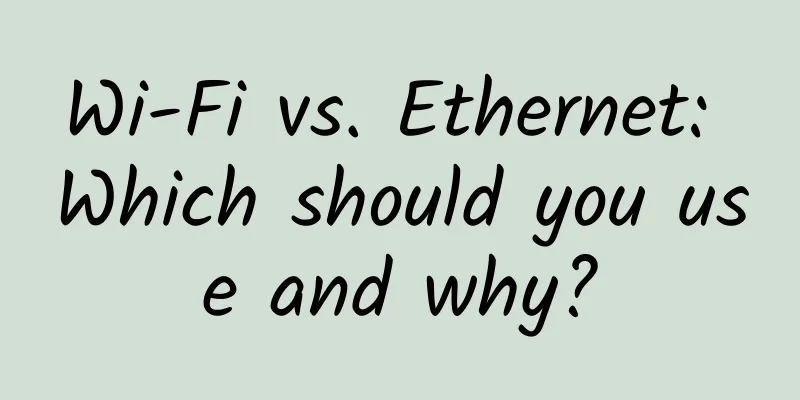There are so many network structures, this one is probably the most controversial one

|
Since its birth in the 1960s, network technology has developed rapidly. The star structure, ring structure, bus structure and other structures in traditional local area networks have played a role in various fields, providing stable network connections and large amounts of data traffic for billions of people around the world. However, there is a LAN technology that was born very early, but due to its complex structure, it has not been taken seriously. However, with the development of wireless network technology to this day, its advantages have been re-valued. This is what Lao Yang wants to talk to you about today. To understand it, you need to take two steps:
1. In the online worldHow many types of networks are there? When talking about the Internet, we must understand how many types of networks there are. I have mentioned this in my previous article, and I will talk about it again today. The basic structures of local area networks include star structure, ring structure, bus structure, distributed structure, tree structure, etc. The most common and widely used star structure is to use the central node as the core, and other nodes are connected to the central node. This structure has higher costs and lower reliability, but it has low latency, simple structure and is easy to manage. In a bus-type structure, all network devices are connected to a bus with no obvious center. Its advantages are simple structure and good scalability, but its disadvantages are also obvious, such as difficult maintenance and difficult fault finding in a branch structure. In order to be safer and more efficient in use, most of the commercial LANs currently in operation use a combination of multiple network topology modes to maximize the performance of the LAN and avoid obstacles. For ordinary users, they usually don’t care how the operator’s computer room should be arranged. The local area network they can most directly access is the network layout of their home, unit or even community. At present, the typical LAN layout adopts a star structure or a multi-layer star structure. The network is connected through the main router, then distributed to each sub-router, and finally connected to different hosts and devices. This kind of wiring is relatively simple to implement and requires fewer cables. This layout method and layout concept spans the wired and wireless eras. For example, at home, users will access the Internet from Internet service providers such as China Telecom and China Unicom, and then use wireless routers to transfer multiple signals or wireless signals for use by multiple wired and wireless devices in the home. The above situation is a typical star structure. The development of local area network topologies such as star structure and bus structure has brought about the explosion of the Internet, but their inherent defects have been unavoidable, such as the security and reliability of data centers, and the difficulty of maintaining bus-type layouts. Although the traditional LAN structure has been strengthened through various means, and even a composite topology has been used, the user experience is still difficult to guarantee because the inherent problems have not been resolved. In order to break through the bottleneck of the traditional LAN structure, in recent years, a network topology that is not new but has not been taken seriously due to technical limitations has come to the fore, that is, Mesh, a mesh network structure. 2. Mesh NetworkWhat is the difference? Speaking of the word Mesh, its English meaning is very simple, which is net, grid, and mesh. From the basic definition of Mesh network, its topology is: all nodes in the network are connected to each other, and each node is connected to at least two other nodes, forming an integrated network between all nodes. In the wired era, it was very difficult to implement a Mesh network due to the existence of network cables. However, in the wireless era, since it is free from the constraints of network cables and through the application of various new technologies, the layout of wireless Mesh networks has become relatively easy. From the perspective of network topology, the characteristics of wireless mesh networks are also very obvious, such as: The nodes are interconnected, all nodes in the local area network are connected together, there are multiple connection channels between any two nodes, and it shows an obvious decentralized trend. It also has a self-configuration function, just like the AP in a wireless mesh network has automatic configuration and centralized management capabilities, which simplifies network management and maintenance. In addition, self-healing, high bandwidth, high utilization and good compatibility are all advantages of its topological structure. From the application perspective, the advantages of wireless mesh networks are also very obvious: 1. Fast deployment and simple installationIn a wireless mesh network, except for a few node devices that need to be connected to an AP via a network cable, most devices only need a power cable, and do not need to be connected to an AP via a network cable. All data is transmitted wirelessly. This not only greatly saves the connection speed, but also reduces the difficulty of wired layout, which is very convenient. 2. Excellent network reliabilityIn common LANs, all data is connected to a single AP for transmission and reception. In a LAN, if there is a central AP, since there is only one path for data transmission, it is easy to cause data congestion or failure in actual use (such as AP disconnection or device damage, etc.). The wireless mesh network has at least one backup path, so the reliability of data transmission is very high. 3. Realize non-line-of-sight transmissionTraditional networks have only one data sending node, which is the central node connected to the AP. Data sending and transmission are effective within the coverage range of the central node, but become ineffective when the distance becomes longer. In a wireless mesh network, each node is equivalent to a repeater, which expands the scope of data coverage and can provide network for users outside the line of sight of the node connected to the AP, greatly improving the application field and coverage of the wireless network. In wireless coverage, the solution commonly used in our company is AP coverage, including enterprises, businesses, hospitals, hotels, exhibition halls, stadiums, etc. This is a very mature wireless coverage solution. The idea is very simple, which is to use multiple APs for wireless coverage instead of pursuing the performance of a single device. Of course, the performance of enterprise products is also very strong. If you have a high budget and higher requirements for the network, you can choose an AP solution, select enterprise-level products, and say goodbye to the technology and solutions of home routers. When switching to a home environment, multiple routers are used to simulate the networking form of enterprise APs. One router acts as the main router to manage the network and network settings. Other routers basically play the role of AP and only forward wireless data. They do not perform DHCP, routing and other functions. The main router is under greater pressure. Under MESH networking, the router's network becomes a logical network with a wireless name, which can have a better roaming effect than the previous router bridge. It supports wireless MESH, which is a lifesaver for families who do not have a whole-house network cable. |
<<: Wi-Fi vs. Ethernet: How Better Is a Wired Connection?
>>: Expert Viewpoint: Is it time to go wireless?
Recommend
What are the five skills required for data center management?
Today, IT managers must be prepared for the vario...
Omdia Observation: Global 5G private network development is still in its early stages
[[376420]] According to the latest report from ma...
Megalayer: Dedicated servers from 299 yuan/month, optimized CN2 lines in mainland China, Hong Kong/Philippines/US VPS annual payment from 159 yuan
Megalayer is a subsidiary of Vofo, founded in 201...
[11.11] UUUVPS US VPS annual payment starts from 91 yuan, Hong Kong CN2 annual payment starts from 182 yuan
UUUVPS (Sanyou Cloud) launched the promotion duri...
How to choose the correct branch jumper for the switch
This article will serve as a guide for using MTP ...
Is this another money-making game? Why are you urging me to switch to 5G when 4G is so good?
At present, the number of 4G users in my country ...
How does SpringBoot ensure interface security? This is how veterans do it!
Hello everyone, I am Piaomiao. For the Internet, ...
TMThosting: VPS monthly payment 15% off annual payment 20% off, dedicated server monthly payment 95% off annual payment 20% off, Seattle/Dallas data center
TMThosting has launched the Dedicated Server &...
Special offer of $46.6/year package for restocking, optional CN2 GIA (DC6/DC9)/Japan SoftBank, etc.
Bandwagonhost restocked its first special annual ...
5G network speed has shrunk? Q3 saw a year-on-year decline of up to 39%
Recently, Ookla, a network connection speed testi...
How to choose IoT communication technology
Communication technology, as a basic technology, ...
ICO is suspended and blockchain needs to develop
ICO disguised as blockchain is like a glass of be...
The emergence of Wi-Fi HaLow promotes IoT applications and innovation
Few emerging technologies have the transformative...
Six requirements for integrating SmartNIC/DPU into existing network infrastructure
The CPU has long been considered the backbone of ...









